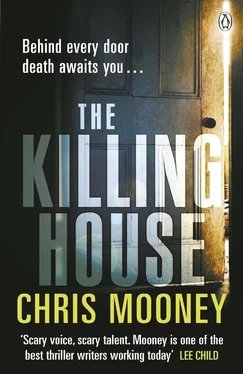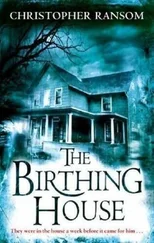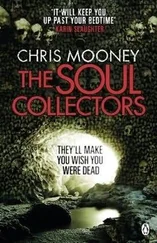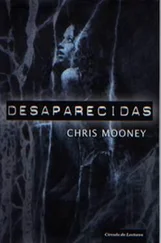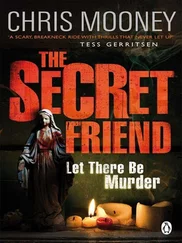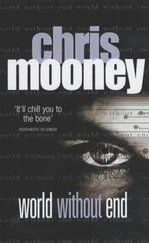Chris Mooney - The Killing House
Здесь есть возможность читать онлайн «Chris Mooney - The Killing House» весь текст электронной книги совершенно бесплатно (целиком полную версию без сокращений). В некоторых случаях можно слушать аудио, скачать через торрент в формате fb2 и присутствует краткое содержание. Жанр: Триллер, на английском языке. Описание произведения, (предисловие) а так же отзывы посетителей доступны на портале библиотеки ЛибКат.
- Название:The Killing House
- Автор:
- Жанр:
- Год:неизвестен
- ISBN:нет данных
- Рейтинг книги:5 / 5. Голосов: 1
-
Избранное:Добавить в избранное
- Отзывы:
-
Ваша оценка:
- 100
- 1
- 2
- 3
- 4
- 5
The Killing House: краткое содержание, описание и аннотация
Предлагаем к чтению аннотацию, описание, краткое содержание или предисловие (зависит от того, что написал сам автор книги «The Killing House»). Если вы не нашли необходимую информацию о книге — напишите в комментариях, мы постараемся отыскать её.
The Killing House — читать онлайн бесплатно полную книгу (весь текст) целиком
Ниже представлен текст книги, разбитый по страницам. Система сохранения места последней прочитанной страницы, позволяет с удобством читать онлайн бесплатно книгу «The Killing House», без необходимости каждый раз заново искать на чём Вы остановились. Поставьте закладку, и сможете в любой момент перейти на страницу, на которой закончили чтение.
Интервал:
Закладка:
An envelope holding five thousand dollars in greasy hundred-dollar bills was tucked inside the suit-jacket pocket along with a small plastic vial containing half a dozen pink and blue pills. Fletcher tucked the vial and iPhone in his pocket, then dragged Corrigan into the dining room and lifted him into the elegant high-backed chair at the head of the table. Fletcher cut off the FlexiCuffs. Then he took out fresh ones and secured the man’s wrists and ankles to the armrests and legs.
Fletcher selected two items from the kitchen. One came to rest inside Mr Corrigan’s mouth. The other was placed on his dinner plate. The man would see it, even in the gloom.
Back upstairs, Fletcher turned on the bedroom lights. The man tied to the bed did not stir, even when he was searched.
His pockets were empty. No identification. Fletcher studied the face. Karim had emailed him several pictures of Rico Herrera. Herrera had a round-shaped face, a gap between his front teeth and a birthmark along his right temple. The man on the bed had a square face, small and even teeth, and no birthmark. This man wasn’t Rico Herrera.
Fletcher moved into the adjoining bathroom. Inside the medicine cabinet he found a surgical-strength bottle of antiseptic. He soaked a facecloth in cold water, returned to the bedroom and placed it on the man’s forehead. Then he cut the zip ties. The man’s arms flopped against his head. He didn’t stir or make a sound. Fletcher laid the man’s arms by his sides. The light brown forearms were punctured and bruised by needle marks.
The nightstand drawers contained an assortment of surgical-spirit prep pads, gauze and plasters, packaged IV needles and syringes. He found vials of the narcotic pain medication Demerol mixed in between saline bags. A folding knife was in a bottom drawer.
Fletcher left to explore the room across the hall. The security-alarm keypad glowed from the wall next to the door. He turned on the lights and filled it with liquid styrofoam.
The master bedroom contained a king-sized bed and a pair of nightstands, a lamp on each one. Both nightstands held alarm clocks. One contained a bottle of hand cream, the other a biography of Winston Churchill. A leather club chair sat in a corner. The walls were bare. The bureau did not contain any framed pictures, and he had seen no pictures downstairs. Inside the bureau drawers he found a mix of men’s and women’s clothing.
Fletcher took in the room, with its Moulin Rouge colours and recycled Louis XIV-style furniture and fabrics: pop Victorian mixed with the taste of a French bordello. A knock-off Gustave Serrurier-Bovy armoire made of rich mahogany stood in a corner. He had seen the original, crafted in 1899 by the late Belgian architect, on display at Paris’s Musee d’Orsay.
Fletcher was more interested in the closet door. It was made of solid wood — the kind of door used primarily on the front or back of a house to prevent intrusion. What made the closet door even more peculiar was the mechanism used to secure it: an electronic lock that required a magnetic keycard.
Gary Corrigan wasn’t carrying a magnetic keycard.
Fletcher wondered if the closet contained its own separate security system. He took out his device resembling an ordinary smartphone and moved it around the edges of the closet and the brushed stainless-steel light switch overhead. The green light did not turn red. There was no electronic security. He tucked the device away and snapped open the tactical pouch containing his various lock-picking tools, selecting a heavy circular ring made of aluminium. It housed four powerful magnets that could bypass any electronic lock.
He slipped the ring over the door handle and then, slowly, turned it clockwise, waiting for the magnetic fields to find the metal parts residing inside the electronic lock… there. Now a quick twist counterclockwise and the lock clicked back. Fletcher flipped the light switch as he opened the door.
31
Here was a long walk-in closet of recessed lighting and custom-made white shelving, shoe racks and cabinetry. The back held a tall built-in bureau with six drawers. Beside it was another Louis XIV-designed chair, this one covered with ivory linen and with cabriole legs of distressed wood. An antique side table sat next to the chair, its top holding an empty highball glass and a half-empty bottle of Maker’s Mark bourbon.
Fletcher turned his attention to some plastic garment bags hanging from steel rods on either side of the closet. There were eleven bags, and the spaces between them were perfectly even. Each bag faced the aisle of light brown carpet, turned at a slight angle so it faced the chair.
He stepped inside. The air was stale and dust swarmed in the cones of light.
Within the clear-plastic bags were clothes belonging to both men and women — complete outfits, the clothing combinations artfully arranged on the hangers as though they were on display for purchase in a store. He found suit jackets draped over shirts with ties and silk scarves. Long-sleeves and short-sleeves and T-shirts paired with chinos and jeans. One bag contained a green hospital smock and scrubs.
The clothes were of various sizes. Sitting underneath each bag was an odd assortment of well-worn footwear- shoes, trainers, boots, even two worn white clogs. Two pairs of women’s shoes were missing heels.
Fletcher inspected a random garment bag. It held a wrinkled linen sports jacket draped over a wrinkled and torn pale blue Oxford-collared shirt. The garment bag next to it contained a pair of men’s jeans. The pocket was ripped, the fabric above the knees covered with grime and dried blood. The accompanying white T-shirt, dirty and mangled, had underarms marred with yellow perspiration stains.
He inspected the built-in bureau’s six drawers. Each one contained men’s and women’s jewellery, laid out on black velvet cushions. Some pieces were bent and broken. Others were scratched or missing a small diamond or stone.
Fletcher sat in the chair. The garment bags faced him.
Eleven bags containing mangled and bloody clothing. Eleven bags for eleven victims. The garments were killing souvenirs. Trophies. He looked at the highball glass. Its rim was smeared with red lipstick. The shooter, the woman in the fur coat, had used this glass. She had sat in this chair, sipped her bourbon and stared at the clothing of her victims.
And she had a male partner. She lived with and slept next to a man every day and every night. The man had to be her partner because there was no way she could hide this grisly tableau from him. Fletcher got to his feet, wondering if the pair had designed the killing museum together.
And how did Gary Corrigan fit into this? He wasn’t the woman’s partner, Fletcher was sure of it. The bedroom’s bureau drawers held XXL jockey vests and boxer shorts. Corrigan had been wearing a form-fitting tank-top vest and Calvin Klein briefs, both in a size large.
Fletcher removed Corrigan’s iPhone and then reached for the small, boxy forensic unit strapped to his tactical belt. He unspooled a cord and connected the end to the iPhone. The unit’s LCD panel came to life and then began the process of extracting the phone’s data.
All the clothes in here belonged to adult men and women. He looked at the sleeping figure on the bed.
Who are you? And why are you tied up to this bed?
It was time to speak with Gary Corrigan. Fletcher slid the highball glass inside an evidence bag, about to shut it when he noticed a faint black residue resting at the bottom, a small collection of particles resembling cigarette ashes.
Not cigarettes ashes, Fletcher thought, looking around the closet. The shelves above the hangers were bare. Kneeling, he searched the area behind the shoes. Behind each one he found a sealed plastic bag holding cremated remains. Human ashes.
Читать дальшеИнтервал:
Закладка:
Похожие книги на «The Killing House»
Представляем Вашему вниманию похожие книги на «The Killing House» списком для выбора. Мы отобрали схожую по названию и смыслу литературу в надежде предоставить читателям больше вариантов отыскать новые, интересные, ещё непрочитанные произведения.
Обсуждение, отзывы о книге «The Killing House» и просто собственные мнения читателей. Оставьте ваши комментарии, напишите, что Вы думаете о произведении, его смысле или главных героях. Укажите что конкретно понравилось, а что нет, и почему Вы так считаете.
